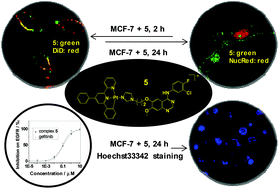Luminescent cyclometallated platinum(ii) complexes: highly promising EGFR/DNA probes and dual-targeting anticancer agents†
Abstract
Cyclometallated platinum(II) complexes, [(C^N^N)PtII(L)]n+ (n = 0 or 1), have attracted much attention due to their potency as luminescent probes for nucleic acids and anticancer agents. Reported herein are four [(C^N^N)PtII(L)]+ complexes (5–8, L = 4-anilinoquinazoline derivative) which exhibit a weak fluorescence emission over 605 to 627 nm upon excitation at 405 nm. The ligation of the cyclometallated platinum cores with EGFR-inhibiting anilinoquinazolines not only confers the resulting complexes with excellent EGFR-inhibiting potency with IC50 values at the nanomolar level, but also enhances their affinity to DNA, in particular to G-quadruplex (G4) DNA. Such interactions produce strongly luminescent EGFR and DNA complexes, respectively, allowing the easy tracing of the cellular uptake and distribution of the platinum complexes and make them potential fluorescent probes for both EGFR and DNA in living cells. Complexes 5 and 6 are highly cytotoxic to the cancer cell lines A549, HeLa, A431 and MCF-7, and selectively inhibit the EGF-stimulated growth of the MCF-7 cell line. Secondary-ion mass spectrometry imaging and ICP-MS analysis demonstrated that the platinum complexes localize both on the cell membrane and in the nuclei of cells associated with EGFR and DNA binding, respectively, further verifying their dual-targeting feature as anticancer agents.



 Please wait while we load your content...
Please wait while we load your content...